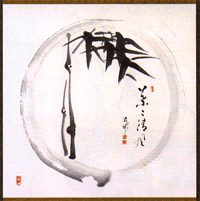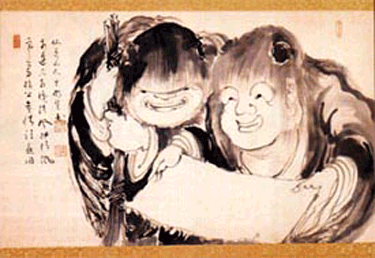Zen Paintings
Their central role in the Japanese Tea Ceremony

Most people have their first encounter with the tea ceremony through a public demonstration of that part of the ritual in which a bowl of tea is made. Isolating this single aspect from the whole has had the unfortunate result of giving the false impression that chanoyu is cold and stiff. In fact, the full tea ritual, of chaji, is three or four hours in length, and involves the host and his or her assistant, five guests and several helpers in the kitchen. Before the tea is made, charcoal for the fire to boil the water is laid in front of the guests and a meal of seven courses is served, including generous pourings of sakè. If the chaji takes place during the night or early morning hours it is done by candlelight. There is talk, conviviality and laughter. Yet everyone involved is also aware of the responsibility of fulfilling their prescribed roles in a way that smoothly and unobtrusively contributes to the success of the event and the good of the whole. Through the experience each participant’s body, mind, heart and spirit are being nourished.
The guiding principles of chanoyu are Wa, Kei, Sei, Kaku (Harmony, Respect, Purity and Tranquility). It is believed that if the first three are present, then tranquility will follow naturally. An expression, which is also often used, is Ichigo Ichie (One time, one meeting). It serves as a reminder not only during the tea ceremony but in our daily lives to stay awake and aware of each moment in time, which is unique, precious and unrepeatable. In Japan, an entire culture has evolved to support and enhance this ritual. Tea has become the embodiment of the arts of traditional architecture, gardens, ceramics, lacquer, baskets, metalwork, kaiseki cooking and Zen painting and calligraphy.
It is the duty and pleasure of the host in planning the event to give great thought to providing the best and most inspiring experience for the guests. The objects the host elects to use will together weave a story and evoke a feeling that will slowly be revealed during the course of the chaji. There will always be a seasonal reference. The story is told in part through the seasonal appropriateness of the food and objects themselves, but mainly through the words of the scroll and the poetic names, which have been given to some of the utensils. These names and the history of the objects are discussed as a vital component of the ritual. The objects are customarily named not by the host, but by a Zen teacher or tea-master who has carefully and intuitively studied the object and given it a poetic name that emphasizes the subtle qualities the object evokes. These names are written on the wooden boxes in which the objects are stored.

The utensils are also chosen with a strong regard for the way they harmonize and interact with each other. This harmony does not mean blandness of any sort, however, and often includes somewhat startling and unexpected contrasts designed to underscore and enhance the unique beauty of each object. For example, among ceramics of an elemental and rustic taste will be, perhaps, a gilded porcelain utensil of refined decoration.
Of all the objects that will be brought together in the performance of a tea ceremony, the scroll that is the writing of a Zen priest is unequivocally the most important. It is the first thing seen upon entering the tearoom and the only object that is honored with a bow. The words of the scroll will set the theme of the tea, but more importantly, it is thought that through the medium of the ink on paper and the intentionality of the priest at the time it was brushed, the character and spiritual power of the writer is present in some way as the guiding influence of the tea event. In Japanese, the writings of Zen priests are called bokuseki, or “ink traces” in English. The bow is meant to show respect for the writer of the scroll and the spiritual meaning of the words.
Ceremonial tea drinking and Zen practice have been intertwined since they were brought together to Japan from China at the end of the twelfth century. But chanoyu did not come into its full flower until the sixteenth century, under its great patriarch Senno Rikyu (1522- 1591). He was a man of aesthetic genius and the arbiter of taste in his time. His creativity and discrimination form the foundation of tea as it is practiced today, as well as what is thought of as uniquely Japanese taste. Among his accomplishments are the development of raku pottery and kaiseki cuisine.
Rikyu was born into the merchant class, became a tea-master who served in this capacity under the military ruler of Japan, Oda Nobunaga (1534-1582) and achieved fame as tea-master to his successor Toyotomi Hideyoshi (1537-1598). He studied with two important tea-masters of his day, Kitamura Dojin (1504-1562) and Takeno Joo (1502-1555) and was greatly influenced in the development of his taste by the earlier figure, Murata Shuko (died 1502). Zen calligraphy was first used in the tea ceremony by Shuko. His Zen teacher, the legendary Ikkyu Sojun (1394-1481) presented him with a treasured scroll of the calligraphy of the Chinese priest Engo Kokugon (1063-1135) as an acknowledgement of Shuko’s enlightenment. This began the custom of hanging the writing of a Zen priest at the tea ceremony.
Rikyu pursued his own study of Zen at Daitokuji Temple in Kyoto with Kokei Sochin (1532-1597), with whom he had a long and close friendship. Although Rikyu owned many ancient treasures, including the Engo calligraphy which he often used in his tea gatherings, he also began the until then unprecedented custom of using the calligraphy of a living Zen priest by hanging the writing of his friend and teacher Kokei.
In addition to the main scroll in the tearoom, which is most often calligraphy, another scroll will be presented in the waiting area where the guests gather prior to entering the tearoom together. This scroll will be of a less serious nature, and will often be a painting.
It will always have some relationship to the primary scroll, and help in developing the theme. In tea taste, repetition of anything is strongly avoided but things are chosen for their subtle cross-references.
Because of the importance of acknowledging the changing seasons in chanoyu, the first eight scrolls were chosen to illustrate what would be appropriate paired scrolls for tea ceremonies held in spring, summer, fall and winter. All of the scrolls shown in this article were brushed by Japanese Zen priests. The translations are by John Stevens, with the exception of the seventh scroll, which is by Stephen Addiss.
– By Belinda Sweet




